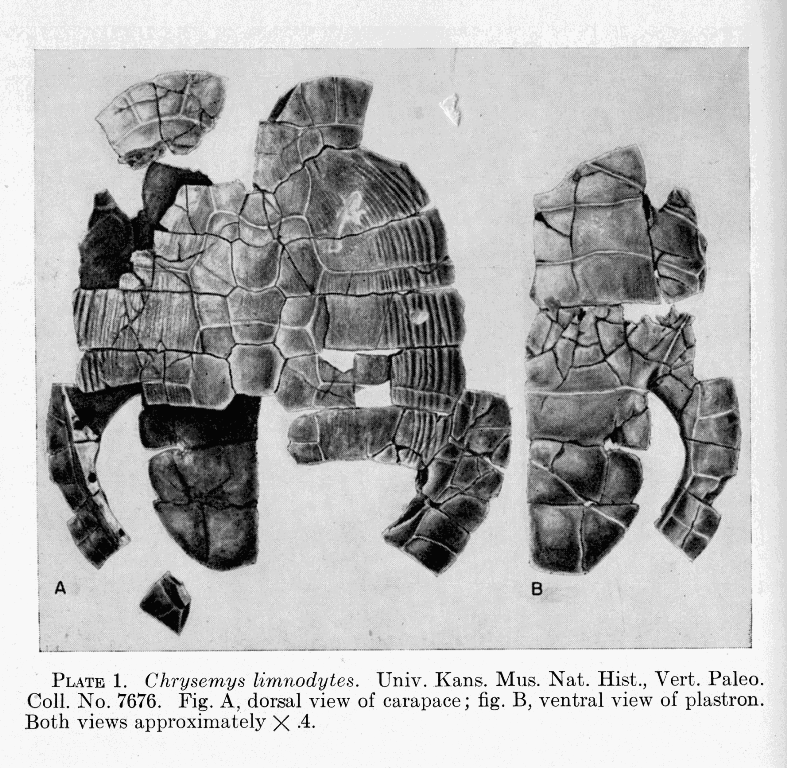A New Extinct Emydid Turtle from the Lower
Pliocene of Oklahoma
BY
EDWIN C. GALBREATH
University of Kansas Publications
Museum of Natural History
Volume 1, No. 16, pp. 265-280, plate 1
August 16, 1948
University of Kansas
LAWRENCE
1948
University of Kansas Publications, Museum of Natural History
Editors: E. Raymond Hall, Chairman; H. H. Lane, Edward H. Taylor
Volume 1, No. 16, pp. 265-280, plate 1
August 16, 1948
University of Kansas
Lawrence, Kansas
PRINTED BY
FERD VOILAND, JR., STATE PRINTER
TOPEKA, KANSAS
1948
22-3340
 Plate 1. Chrysemys limnodytes. Univ. Kans. Mus. Nat. Hist., Vert. Paleo.Coll. No. 7676. Fig. A, dorsal view of carapace; fig. B, ventral view of plastron.Both views approximately × .4.
Plate 1. Chrysemys limnodytes. Univ. Kans. Mus. Nat. Hist., Vert. Paleo.Coll. No. 7676. Fig. A, dorsal view of carapace; fig. B, ventral view of plastron.Both views approximately × .4.A New Extinct Emydid Turtle from the Lower Pliocene
of Oklahoma
By
EDWIN C. GALBREATH
In the summer of 1946 a party from the University of KansasMuseum of Natural History visited exposures of the Laverne formationin Beaver County, Oklahoma, at the invitation of Dr. StuartSchoff of the United States Geological Survey. When examiningthe marl beds an Emydid turtle was discovered which appears tobe an unnamed species of the genus Chrysemys. A description ofthe new species follows.
Chrysemys limnodytes, new species
Holotype.—University of Kansas Museum of Natural History No. 7676,vertebrate paleontological collection, a turtle consisting of a fragmental anteriorportion of a carapace, left part of the plastron, and several marginalscollected by the 1946 paleontological field party of the University of KansasMuseum of Natural History.
Geological Age and locality.—Marl beds of the Laverne formation, earlyPliocene age, in SW 1/4 Sec. 15, T. 4 N., R. 25 ECM, Beaver County, Oklahoma.The specimen was removed from the marl immediately below the fossilleaf zone (see Chaney and Elias, 1936; Frye and Hibbard, 1940).
Diagnosis.—Size large (see measurements) and differing from other speciesof Chrysemys in having: The anterior end of the carapace broadly concave,the posterolateral marginals not greatly flared, the posterior end of the plastronbroadly indented, the carapace more sculptured and relatively wider.
Description of type.—The specimen had been badly damaged before preservation,and had suffered further damage from exposure before discovery. Theanterior and posterior lobes of the plastron had been folded over the bridge,forming a three-ply thickness of bone. Of the carapace, only the followingparts are known: Fragment of the nuchal; right 1st, 7th, 8th, and 9th marginals,left 1st, 2d, 7th, 8th, 9th, and 11th marginals; costals 1-5 on the rightside; costals 1-4 on the left side; and 1st, 2d, 3d, and 4th neurals. The lefthalf of the plastron is relatively complete, lacking only the epiplastron andent